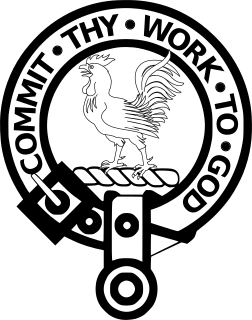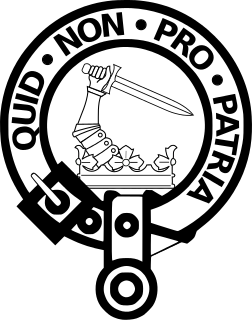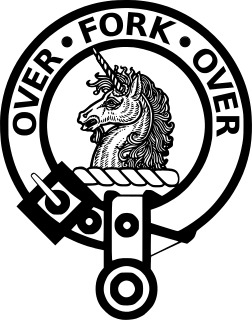| Clan Leask | |||
|---|---|---|---|
 | |||
| Motto | Virtute Cresco (Lat. I grow by virtue) [1] | ||
| Profile | |||
| Region | Highlands | ||
| Chief | |||
 | |||
| Jonathan Leask of that Ilk | |||
| Chief of the Name and Arms of Leask | |||
| |||
| |||
Clan Leask is a Scottish clan. [2]
| Clan Leask | |||
|---|---|---|---|
 | |||
| Motto | Virtute Cresco (Lat. I grow by virtue) [1] | ||
| Profile | |||
| Region | Highlands | ||
| Chief | |||
 | |||
| Jonathan Leask of that Ilk | |||
| Chief of the Name and Arms of Leask | |||
| |||
| |||
Clan Leask is a Scottish clan. [2]
There are several possible origins of the surname Leask. [2] One possibility is that it is a diminutive of the Anglo-Saxon word lisse, which means happy. [2] In the Norse language it means a stirring fellow. [2] Professor Leask of Aberdeen believed that the ancestor of the Leaks was Liscus who was chief of the Haedui, a tribe of Gauls who were described by Julius Caesar during his Gallic Wars. [2] One of the greatest fortresses in France was the Castle of Boulogne, a possession of Charlemagne which at one time belonged to a family called de Lesque. [2] An early reference to the name is that of Erik Leask who was reputedly chamberlain to the king of Denmark. [2]
In 1296 William de Laskereske appears on the Ragman Rolls submitting to Edward I of England. [2] In about 1345 William Leask received a charter of confirmation to his lands of Leskgoroune or Leskgaranne from David II of Scotland, son of Robert the Bruce. [2] He might be the same William Leysk who was recorded in the parish records of the church at Ellon, Aberdeenshire as: William de Laysk, the elder, Lord of that Ilk, bequeathed a pound of wax yearly to the altar of the Holyrood in the church of St Mary of Ellon. [2]
In 1390 the second known chief of Clan Leask who was ballie of the barony of Findon, inherited half of the lands of Henry de Brogan, Lord of Achlowne. [2] He also appears as a witness to a charter by the Earl of Orkney in 1391. [2]
In the middle of the 15th century a younger son of Leask went to Orkney at the request of the earl, who had formed a court at Kirkwall Palace. [2] There a branch of the Clan Leask was formed which still shows the longest unbroken male lines of the clan. [2]
The third chief of Clan Leask, Wilfred, signed a bond of Manrent in favour of William Hay, Earl of Erroll in 1456 and also resigned his lands in favour of his son and heir. [2] From this point onwards the connection with the Clan Hay appears to have remained strong. [2] When the Cheynes of Esslemont allied themselves with the Hays their bond was signed at the Chapel of Laske in 1499. [2]
In 1574 following the deposition of Mary, Queen of Scots, William Leask, seventh chief of Clan Leask signed an oath of allegiance to the child James VI of Scotland. [2]
The register of the Privy Seal records that in 1615 a complaint was made from Alexander Leask that Adam Gordon, brother of the Laird of Gight, put violent hands upon him at the Yet of Leask, wounding him grievously. [2] Later that year the Gordons again attacked the Leasks, setting upon a son of the chief for which George Gordon was outlawed. [2] In 1616, William Leask of that Ilk was accosted by John Gordon of Ardlogy and a party of men with pistolets and hagbuts. [2]
In 1672 Alexander Leask of that Ilk was amongst the noblemen who recorded their coats of arms in a newly established public register. [2] Towards the end of the seventeenth century disaster overtook the family after they invested in the failed Darien scheme, a trading venture with Central America intended to rival the East India Company that had been established in London. [2] Alexander Leask of that Ilk, the thirteenth chief was forced to give up his estates which were taken over by Robert Cumming. [2]
Little is known of the Clan Leask between the disaster of the late seventeenth century until 1963, when a descendant managed to buy back a portion of the family lands and established the Leask Society, with the support of other prominent Leasks. This includes Lieutenant General Sir Henry Leask, who was a governor of Edinburgh Castle and General Officer commanding the Army in Scotland. [2] In 1968 Moira Anne Helgesen was granted the chiefship of the clan by the Lord Lyon King of Arms, [2] whereupon she changed her name and became: Madam Anne Leask of Leask. She died in April 2008 and was succeeded in the chiefship of the clan by Jonathan Leask, who became the 23rd chief of Clan Leask. [3]

Clan Ross is a Highland Scottish clan. The original chiefs of the clan were the original Earls of Ross.

Clan Farquharson of Invercauld is a Highland Scottish clan and is a member of Clan Chattan.

Clan Gordon, also known as the House of Gordon, is a Scottish clan. The chief of the clan is the powerful Earl of Huntly, and now also the Marquess of Huntly. During the Wars of Scottish Independence in the 13th century, the Gordons supported William Wallace in the cause of independence. In the 15th century, the chiefship of the clan passed to an heiress, who married into the Seton family and her male descendants assumed the surname Gordon and continued as chiefs of the clan. The Gordons assisted in defeating the rebellion of the Earl of Douglas also in the 15th century. In the 16th century, the Gordons as Catholics feuded with their Protestant neighbors the Clan Forbes and also defeated at the Battle of Glenlivet, the Protestant Earl of Argyll. During the Wars of the Three Kingdoms of the 17th century, the Gordons supported the Royalist cause. During the Jacobite rising of 1715 the Clan Gordon was Jacobite. During the Jacobite rising of 1745, their chief, then the Duke of Gordon, pledged his support to the British-Hanoverian Government, but his clan remained Jacobite.

Clan Gunn is a Highland Scottish clan associated with lands in northeastern Scotland, including Caithness, Sutherland and, arguably, the Orkney Isles. Clan Gunn is one of the oldest Scottish Clans, being descended from the Norse Jarls of Orkney and the Pictish Mormaers of Caithness.

Clan Brodie is a Scottish clan whose origins are uncertain. The first known Brodie chiefs were the Thanes of Brodie and Dyke in Morayshire. The Brodies were present in several clan conflicts, and during the civil war were ardent covenanters. They resisted involvement in the Jacobite uprisings, and the chief's family later prospered under the British Empire in colonial India.

Clan Sutherland is a Highland Scottish clan whose traditional territory is the shire of Sutherland in the far north of Scotland. The chief of the clan was also the powerful Earl of Sutherland, however in the early 16th century this title passed through marriage to a younger son of the chief of Clan Gordon. The current chief is Alistair Sutherland who holds the title Earl of Sutherland.

Clan Boyd is a Lowland Scottish clan and is recognized as such by the Lord Lyon King of Arms.

Clan Mackinnon or Clan Fingon is a Highland Scottish clan associated with the islands of Mull and Skye, in the Inner Hebrides.

Clan Sinclair is a Highland Scottish clan who held lands in Caithness, the Orkney Islands, and the Lothians. The chiefs of the clan were the Barons of Roslin and later the Earls of Orkney and Earls of Caithness. The Sinclairs are believed to have come from Normandy to England during the Norman conquest of England, before arriving in Scotland in the 11th century. The Sinclairs supported the Scottish Crown during the Scottish–Norwegian War and the Wars of Scottish Independence. The chiefs were originally Barons of Roslin, Midlothian and William Sinclair, 1st Earl of Caithness and Baron of Roslin founded the famous Rosslyn Chapel in the 15th century. He split the family lands, disinheriting his eldest son from his first marriage, William, who later became the second Lord Sinclair, instead giving the lands of Caithness to the second son from his second marriage, William Sinclair, 2nd Earl of Caithness, in 1476, and the lands at Roslin to his eldest son from his second marriage, Sir Oliver Sinclair. In the 16th century the Sinclairs fought against England during the Anglo-Scottish Wars and also feuded with their neighbors the Clan Sutherland. During the Jacobite rising of 1715 the Sinclairs supported the Jacobite cause, but during the Jacobite rising of 1745, while the clan largely had Jacobite sympathies, their chief, the Earl of Caithness, supported the British-Hanoverian Government. The current chief is Malcolm Sinclair, 20th Earl of Caithness.

Clan Murray is a Highland Scottish clan. The chief of the Clan Murray holds the title of Duke of Atholl. Their ancestors who established the family in Scotland in the 12th century were the Morays of Bothwell. In the 16th century descendants of the Morays of Bothwell, the Murrays of Tullibardine, secured the chiefship of the clan and were created Earls of Tullibardine in 1606. The first Earl of Tullibardine married the heiress to the Stewart earldom of Atholl and Atholl therefore became a Murray earldom in 1626. The Murray Earl of Atholl was created Marquess of Atholl in 1676 and in 1703 it became a dukedom. The marquess of Tullibardine title has continued as a subsidiary title, being bestowed on elder sons of the chief until they succeed him as Duke of Atholl.

Clan Buchanan is a Highlands Scottish Clan whose origins are said to lie in the 1225 grant of lands on the eastern shore of Loch Lomond to clergyman Sir Absalon of Buchanan by the Earl of Lennox.

Clan Dewar is a Scottish clan.

Clan Cunningham is a Scottish clan. The traditional origins of the clan are placed in the 12th century. However, the first contemporary record of the clan chiefs is in the thirteenth century. The chiefs of the Clan Cunningham supported Robert the Bruce during the Wars of Scottish Independence. In the 15th and 16th centuries, the Clan Cunningham feuded with the Clan Montgomery. Historically, the chief of Clan Cunningham held the title of Earl of Glencairn. However, in modern times the chief of the clan is Cunningham of Corsehill. On 18 December 2013, Sir John Christopher Foggo Montgomery Cunninghame, Baronet of Corsehill, was recognized by Lord Lyon as Clan Chief after the chiefship had been vacant for over 200 years.

Clan Moncreiffe is a Highland Scottish clan.

Clan Kincaid is a Scottish clan.
Clan Strachan is a Scottish clan originating from the barony of Strachan, in Aberdeenshire. The clan does not have a chief, therefore it is considered by Court of the Lord Lyon and the Stand Council of Scottish Chiefs as an Armigerous clan.

Clan Swinton is a Lowland Scottish clan.

Clan Wedderburn is a Lowland Scottish clan.

Clan Cumming, also known as Clan Comyn, is a Scottish clan from the central Highlands that played a major role in the history of 13th-century Scotland and in the Wars of Scottish Independence. The Clan Comyn were the most powerful family in 13th-century Scotland, until they were defeated in civil war by their rival to the Scottish throne, Robert the Bruce.
Hugh Fraser, 3rd Lord Lovat was a Scottish peer and Chief of Clan Fraser of Lovat from 1524 until 1544.